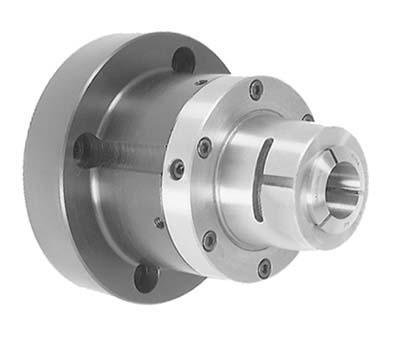
Dunham Tool manufactures a high-quality 2j CNC collet chuck, 5c collet chuck, 16c collet chuck and 3j CNC collet chuck, as well as a 1c collet chuck and 3c collet chuck.
These precision lathe chucks will mount directly to American Standard (A4, A5, A6, A8) and Camlock (D4, D5, D6, D8) style spindles. The Dunham Tool lathe chucks are also frequently used on cylindrical grinders, rotary tables and many other machines. According to a Dunham news release, the company will provide all correct mounting adapters for spindle and rotary tables as well as draw tube adapters to accommodate your spindle, rotary table and draw tube requirements.
These CNC collet chuck systems have a built-in concentricity adjustment (under 0.00050" TIR) and can be mounted on all American Standard spindles in less than 20 minutes. Only one complete lathe chuck assembly is required because each spindle adapter of the assembly will accept any Dunham Tool 16c, 2j, 3j and 5c collet adapter. Change-over is said to be quick and easy by the removal and replacement of only six bolts on the collet adapter. Also available for Camlock style spindles.
Dunham air actuated collet chuck assemblies for converting CNC lathes and grinders to workholding with 16c, 2j, 3j and 5c collets are available.
Contact Details
Related Glossary Terms
- chuck
chuck
Workholding device that affixes to a mill, lathe or drill-press spindle. It holds a tool or workpiece by one end, allowing it to be rotated. May also be fitted to the machine table to hold a workpiece. Two or more adjustable jaws actually hold the tool or part. May be actuated manually, pneumatically, hydraulically or electrically. See collet.
- collet
collet
Flexible-sided device that secures a tool or workpiece. Similar in function to a chuck, but can accommodate only a narrow size range. Typically provides greater gripping force and precision than a chuck. See chuck.
- computer numerical control ( CNC)
computer numerical control ( CNC)
Microprocessor-based controller dedicated to a machine tool that permits the creation or modification of parts. Programmed numerical control activates the machine’s servos and spindle drives and controls the various machining operations. See DNC, direct numerical control; NC, numerical control.
- lathe
lathe
Turning machine capable of sawing, milling, grinding, gear-cutting, drilling, reaming, boring, threading, facing, chamfering, grooving, knurling, spinning, parting, necking, taper-cutting, and cam- and eccentric-cutting, as well as step- and straight-turning. Comes in a variety of forms, ranging from manual to semiautomatic to fully automatic, with major types being engine lathes, turning and contouring lathes, turret lathes and numerical-control lathes. The engine lathe consists of a headstock and spindle, tailstock, bed, carriage (complete with apron) and cross slides. Features include gear- (speed) and feed-selector levers, toolpost, compound rest, lead screw and reversing lead screw, threading dial and rapid-traverse lever. Special lathe types include through-the-spindle, camshaft and crankshaft, brake drum and rotor, spinning and gun-barrel machines. Toolroom and bench lathes are used for precision work; the former for tool-and-die work and similar tasks, the latter for small workpieces (instruments, watches), normally without a power feed. Models are typically designated according to their “swing,” or the largest-diameter workpiece that can be rotated; bed length, or the distance between centers; and horsepower generated. See turning machine.
- spindle adapter
spindle adapter
Bushing or toolholder that permits affixing a variety of taper- and straight-shank tools to a machine spindle.
